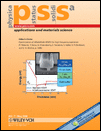Gd3+ and Eu2+ local environment in Ca1–xEuxB6 (0.0001 ≤ x ≤ 0.30) and Ca1–xGdxB6 (0.0001 ≤ x ≤ 0.01)
Abstract
Local environment of Gd3+ and Eu2+ 4f7 ions, S = 7/2, in Ca1–x Eux B6 (0.0001 ≤ x ≤ 0.30) and Cax Gdx B6 (0.0001 ≤ x ≤ 0.01) is investigated by means of electron spin resonance (ESR). For x ≤ 0.001 the spectra show resolved fine structures due to the cubic crystal electric field and, in the case of Eu, the hyperfine structure due to the nuclear hyperfine field is also observed. The resonances have Lorentzian line shape, indicating insulating host for the Gd3+ and Eu2+ ions. As x increases, the ESR lines broaden due to local distortions caused by the Ca/Gd,Eu ions substitution. For Gd (x ≈ 0.001) and Eu (x ≈ 0.02), the spectra present superposition of Lorentzian and Dysonian resonances, suggesting a coexistence of insulating and metallic hosts for the Gd3+ and Eu2+ ions. The Gd3+ and Eu2+ fine structures are still observable up to x ≈ 0.003 for Gd and x ≈ 0.15 for Eu. For larger values of x the fine and hyperfine structures are no longer observed, the line width increases, and the line shape becomes pure Dysonian anticipating the metallic and semimetallic character of GdB6 and EuB6, respectively. These results clearly show that in the low concentration regime the Ca1–x Rx B6 (R = Gd, Eu) systems are intrinsically inhomogeneous. No evidence of weak ferromagnetism (WF) was found in the ESR spectra of either metallic or insulating phases of these compounds, suggesting that, if WF is present in these materials, the Gd3+ and Eu2+ 4f7-electrons are shielded from the WF field. (© 2006 WILEY-VCH Verlag GmbH & Co. KGaA, Weinheim)




